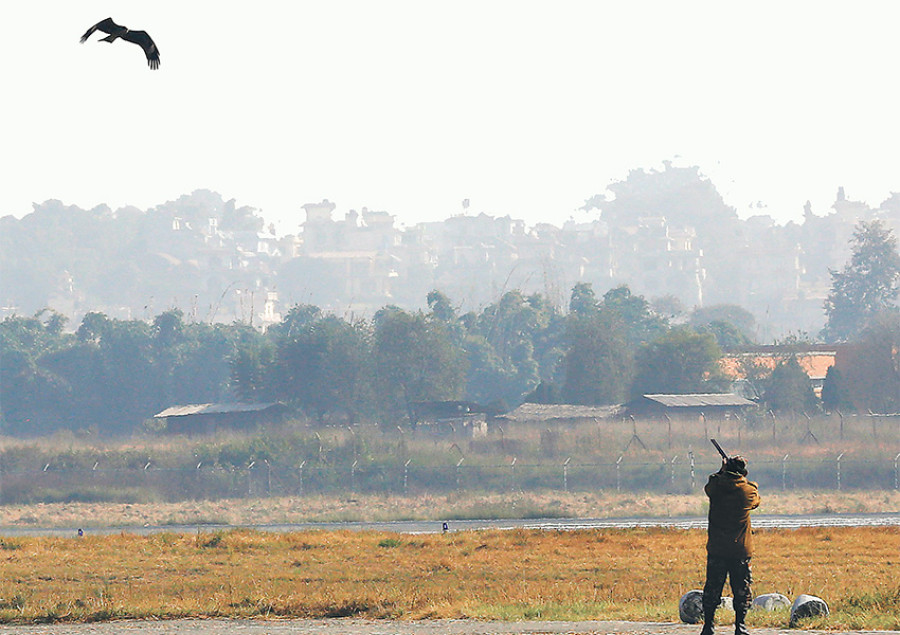Opinion
Flight risks
As an air traffic controller in the 1990s, I had to close down the airport due to bird activity
Tri Ratna Manandhar
On October 9, 1996, a Thai Airways Flight 312 bound for Bangkok narrowly escaped a major mishap when it slammed into a group of vultures during take-off from Tribhuvan International Airport (TIA). The Thai pilot acted very calmly and continued with the predetermined take-off procedure. Once the Airbus 330-600 had stabilised in the air, he turned around and made an emergency landing at the TIA. The jet was carrying 228 persons including the crew. The passengers were unharmed. However, five dead vultures were recovered from the impact site, and one of the aircraft’s engines was severely damaged, requiring it to be grounded for several days. The incident was front-page news in The Kathmandu Post. ‘Thai jet survives major mishap’, the headline screamed. One American passenger named Matt Carpenter even got the entire crew to sign autographs on a copy of the newspaper.
Adamant birds
Bird hazards are a constant threat at the TIA, especially from September to November. During those months, earthworms come out of the grass seeking warmth and die on the runway. This attracts vultures that come to feed on the abundant supply of earthworms. There used to be landfill sites, garbage dumps and uncontrolled commercial activities close to the runway which attracted birds, creating a great nuisance for flight operations. I was one of the air traffic controllers (ATC) on duty that day and I vividly remember the intense bird activities around the TIA. All the available techniques and resources had been deployed to scare away the birds, and helicopters were even requested to hover over the runway. The airport’s fire hoses were also used to drive them away. But the vultures were very adamant. They would fly a short distance before returning to the runway.
An Indian Airlines (IA) flight from Delhi was inbound even as the airport was encountering intense bird activities. The pilots opted to land despite the warnings of the ATCs. Fortunately, the landing was safe. After landing, the upset IA pilots requested us to get rid of them before their next flight. It was very unfortunate that they did not know about the ground team’s enormous efforts to keep the runway clear.
Timid authorities
About half an hour after the IA flight landed, Thai Flight 312 requested clearance for takeoff. The ATC informed the pilots about the severe bird activities around the airport. Since Thai Airways was very particular about maintaining their schedule, they decided to depart in spite of the precarious bird activities. It was evident that the ATC was not comfortable with issuing a clearance to Flight 312. During such difficult circumstances, junior ATCs usually seek their supervisor’s help to deal with the situation. The supervisor had to take over and started giving authoritative instructions to the pilot though the airport was not closed.
Recalling that incident from almost 20 years ago and trying to figure out why the supervisor did not stop the Thai flight and left everything to the pilot, I think there were several reasons behind his decision. The first reason was obviously the dominant nature of Thai Airways and their link with the higher authorities. Second, the IA flight had landed safely just half an hour earlier. Third, and may be most importantly, there was no history of the airport being closed as a result of bird activity. In addition, the ATCs were known for their humility when dealing with pilots. As the investigators of the crash of PIA Flight 268 in 1992 had also noted, “Nepalese ATCs were timid and reluctant to intervene in what they saw as piloting matters.”
Setting a precedent
A year after the Thai incident, I was working as the supervisor at the control tower. There was high level of bird activities around the TIA, and I was feeling a bit apprehensive as I recalled the Thai incident. As usual, all the efforts to scare away the birds failed. In the meantime, there was an Aeroflot flight inbound from Moscow. The Aeroflot aircraft was informed well in advance about the hazardous bird activities at the TIA. The ground team was struggling hard to shoo away the birds before the plane arrived, but all their efforts were in vain and bird activities became even more intense. They reached an alarmingly critical level as the Aeroflot flight was nearing Kathmandu.
I consulted my seniors about closing down the airport, but no one wanted to be involved in taking such a decision. Ultimately, I took the unprecedented action of closing down the airport. The Aeroflot jet circled over Kathmandu for a few minutes and then headed for Delhi as there was no sign of improvement. The next day, the Aeroflot flight landed in Kathmandu with its Delhi-based senior executive officer on board. As soon as the aircraft landed, he headed straight to the general manager of the TIA to submit a formal letter asking for compensation for the loss caused by the flight’s diversion. I was immediately summoned by the general manager and asked to explain my actions. I had a very tough time convincing them as nobody made an attempt to understand the real circumstances. I did feel very sorry for closing the airport. However, my decision had been right and it set a precedent.
Over the last several years, there have been significant improvements in the TIA’s Air Traffic Control system. The Licensing and Rating system has been introduced and the ATCs are paid a fair compensation in terms of Rating Allowance and Stress Allowance. All those positive changes have helped to improve the confidence and morale of ATCs. Most importantly, as far as safety is concerned, ATCs have high professional confidence and do not hesitate to intervene and use their authority when the situation warrants it. Bird strike problems at airports are universal in nature and not unique to the TIA. Even though every possible technique is employed to prevent bird strikes, a number of incidents are reported every year.
Manandhar is a former director general of the Civil Aviation Authority Nepal




 11.12°C Kathmandu
11.12°C Kathmandu











